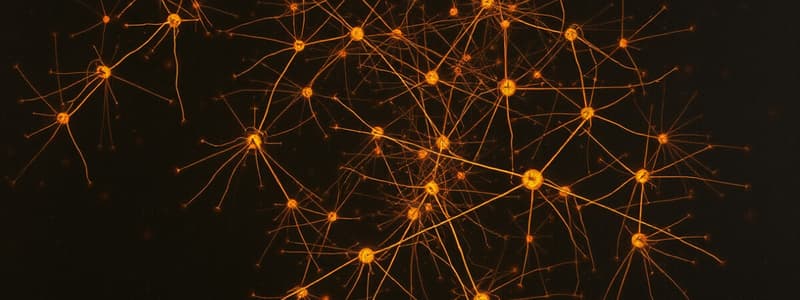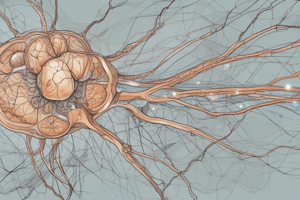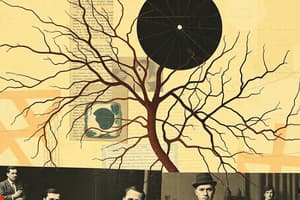Podcast
Questions and Answers
What is the primary function of upper motor neurons located in the cerebral cortex?
What is the primary function of upper motor neurons located in the cerebral cortex?
- Regulation of muscle tone
- Initiation of voluntary movements (correct)
- Activation of α-motor neurons
- Mediating sensory-motor reflexes
Which structure plays a key role in maintaining posture and balance in response to sensory inputs?
Which structure plays a key role in maintaining posture and balance in response to sensory inputs?
- Cerebellar neurons
- Upper motor neurons in the brainstem (correct)
- Local circuit neurons
- α-motor neurons
Which type of neurons are primarily responsible for activating α-motor neurons?
Which type of neurons are primarily responsible for activating α-motor neurons?
- Local circuit neurons (correct)
- Interneuron pathways
- Sensory neurons
- Upper motor neurons
What capability do local circuit neurons possess even without inputs from the brain?
What capability do local circuit neurons possess even without inputs from the brain?
Where are local circuit neurons primarily located?
Where are local circuit neurons primarily located?
Which of the following best describes the role of upper motor neurons in skilled movements?
Which of the following best describes the role of upper motor neurons in skilled movements?
What sources do upper motor neurons in the brainstem respond to for their regulatory functions?
What sources do upper motor neurons in the brainstem respond to for their regulatory functions?
What is a critical characteristic of local circuit neurons in terms of their operation?
What is a critical characteristic of local circuit neurons in terms of their operation?
What role does the cerebellum play in relation to motor control?
What role does the cerebellum play in relation to motor control?
Which type of motor unit has the lowest activation threshold and is the first to be recruited?
Which type of motor unit has the lowest activation threshold and is the first to be recruited?
Which statement accurately describes the basal ganglia's function?
Which statement accurately describes the basal ganglia's function?
Which motor unit type is associated with the MyHC-I isoform?
Which motor unit type is associated with the MyHC-I isoform?
What is true about motor units in muscle contraction?
What is true about motor units in muscle contraction?
What is a characteristic of fast fatigable (FF) motor units?
What is a characteristic of fast fatigable (FF) motor units?
How do cerebellum and basal ganglia differ in their functions regarding movement?
How do cerebellum and basal ganglia differ in their functions regarding movement?
What can result from a malfunction in the basal ganglia?
What can result from a malfunction in the basal ganglia?
Which type of muscle fibres are fast fatigue-resistant (FR) motor units associated with?
Which type of muscle fibres are fast fatigue-resistant (FR) motor units associated with?
What defines a motor neuron pool?
What defines a motor neuron pool?
Which motor unit type tends to innervate a larger number of powerful muscle fibres?
Which motor unit type tends to innervate a larger number of powerful muscle fibres?
Which of the following is NOT characteristic of the cerebellum?
Which of the following is NOT characteristic of the cerebellum?
What distinguishes slow (S) motor units from fast motor units?
What distinguishes slow (S) motor units from fast motor units?
What is the main structural feature of a lower motor neuron axon?
What is the main structural feature of a lower motor neuron axon?
What method can be used for classifying muscle fibre types?
What method can be used for classifying muscle fibre types?
What is a key feature of fast fatigable (FF) motor units regarding their mitochondria?
What is a key feature of fast fatigable (FF) motor units regarding their mitochondria?
What is the primary focus of ATPase histochemistry in muscle analysis?
What is the primary focus of ATPase histochemistry in muscle analysis?
Which MyHC isoform is added to the classical types in the electrophoretic SDS-PAGE method?
Which MyHC isoform is added to the classical types in the electrophoretic SDS-PAGE method?
What is an average innervation ratio for the soleus muscle?
What is an average innervation ratio for the soleus muscle?
Which of the following muscles has the highest innervation ratio?
Which of the following muscles has the highest innervation ratio?
What phenomenon describes the change in muscle fiber phenotype due to electrical nerve stimulation?
What phenomenon describes the change in muscle fiber phenotype due to electrical nerve stimulation?
How many muscle fibers can the extraocular muscles control per motor unit on average?
How many muscle fibers can the extraocular muscles control per motor unit on average?
What is a significant outcome of chronic electrical nerve stimulation on muscle fibers after 56 days?
What is a significant outcome of chronic electrical nerve stimulation on muscle fibers after 56 days?
Which of these muscle fibers types may correspond to both MyHC isoforms IIb and IIx?
Which of these muscle fibers types may correspond to both MyHC isoforms IIb and IIx?
What does the size principle in motor unit recruitment explain?
What does the size principle in motor unit recruitment explain?
According to Ohm's Law, which formula is correctly matched with its components?
According to Ohm's Law, which formula is correctly matched with its components?
How does the size of a neuron's resistance affect its voltage change with the same synaptic input?
How does the size of a neuron's resistance affect its voltage change with the same synaptic input?
Why can smaller motoneurons reach action potential even with smaller voltage changes?
Why can smaller motoneurons reach action potential even with smaller voltage changes?
Which of the following statements about motoneuron recruitment is true?
Which of the following statements about motoneuron recruitment is true?
If a motoneuron has higher resistance, what effect does this have on the current it can generate with a given voltage?
If a motoneuron has higher resistance, what effect does this have on the current it can generate with a given voltage?
Which equation correctly reflects the relationship between current, voltage, and resistance for a neuron?
Which equation correctly reflects the relationship between current, voltage, and resistance for a neuron?
What happens to the voltage change across a small motoneuron as compared to a large motoneuron when subjected to the same synaptic input?
What happens to the voltage change across a small motoneuron as compared to a large motoneuron when subjected to the same synaptic input?
Flashcards are hidden until you start studying
Study Notes
Upper Motor Neurons (UMNs)
- Cell bodies are localized in the cerebral cortex or brainstem.
- UMNs in the cortex initiate voluntary movements and manage complex skilled sequences.
- Axons of UMNs synapse with local circuit neurons and sometimes directly with lower motor neurons for distal muscles.
- UMNs in the brainstem regulate muscle tone and control posture and balance influenced by sensory inputs (vestibular, auditory, visual, somatic).
Local Circuit Neurons
- Interneurons responsible for activating α-motor neurons.
- Located near corresponding α-motor neurons in the spinal cord or cranial nerve motor nuclei.
- Receive descending projections from higher centers and mediate sensory-motor reflexes.
- Maintain interconnections for rhythmic and stereotyped behaviors.
- Can coordinate involuntary movements like walking independently from brain inputs.
Cerebellum and Basal Ganglia
- Complex circuits that regulate upper motor neurons without containing motor neurons themselves.
- The cerebellum detects and corrects motor errors and is essential for motor learning.
- The basal ganglia suppress unwanted movements and prepare UMNs for movement initiation, with malfunctions linked to Parkinson’s and Huntington’s diseases.
Motor Neuron – Muscle Relationship
- Each lower motor neuron innervates muscle fibers within a single muscle and can branch to synapse on multiple fibers.
- Each muscle fiber is innervated by one α-motor neuron, which activates all fibers it innervates upon reaching an action potential threshold.
- A motor unit consists of a motor neuron and the muscle fibers it innervates, ensuring even distribution of contractile force across a muscle.
Motor Unit Types
- Motor units vary in size, with size correlated to the number of muscle fibers innervated and the force generated.
- Small α-motor neurons innervate fewer muscle fibers for low force, while larger neurons innervate more fibers for greater force.
- Three major motor unit types include:
- Slow (S) Motor Units: Small size, low activation threshold, high endurance, important for sustained contractions.
- Fast Fatigue-Resistant (FR) Motor Units: Intermediate size, generates higher force than S units, fatigue-resistant.
- Fast Fatigable (FF) Motor Units: Largest size, highest force output, easily fatigable.
Muscle Fiber Typing
- Muscle fiber types can be classified via ATPase histochemistry or SDS-PAGE electrophoresis.
- ATPase histochemistry identifies fiber types (Type I, IIa, IIb) based on staining.
- SDS-PAGE separates proteins by mass to determine MyHC protein types, including additional type IIx.
- Potential overlap in fiber types due to MyHC isoform variations (e.g., IIb may correspond to MyHC-IIb or IIx).
Muscle Unit Distribution
- Different muscles have varying innervation ratios; for example, the soleus has 180 fibers per motor neuron, while gastrocnemius has 1000-2000.
- Extraocular muscles have a low innervation ratio of 3 fibers per unit, allowing for fine control.
- Use-dependent motor unit plasticity allows for fiber phenotype shifts after chronic electrical stimulation, which has implications for therapies in paralyzed patients.
Regulation of Muscle Force
- Recruitment follows the size principle; smaller motor neurons are activated first with lower thresholds.
- Describes the relationship defined by Ohm’s Law (I = V / R), with regard to current, voltage, and resistance.
- Smaller neurons have higher resistance and lower voltage change for action potential induction, maintaining the same synaptic input efficacy across neuron sizes.
Studying That Suits You
Use AI to generate personalized quizzes and flashcards to suit your learning preferences.




